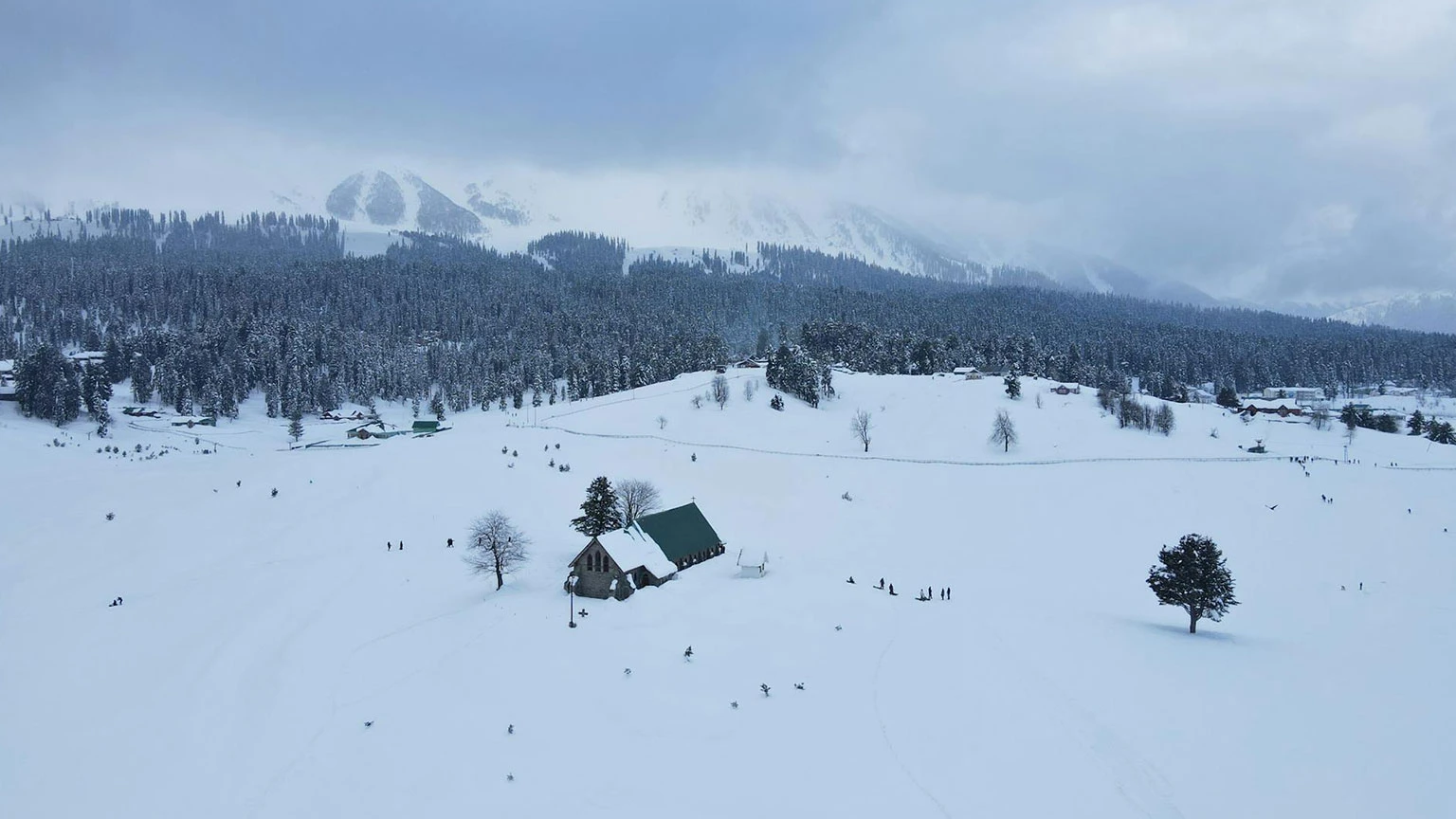Srinagar, the summer capital of J&K, lies in the heart of the Kashmir Valley, positioned along the tranquil Jhelum River. Four districts and Ladakh UT surround the city. To the north lies Ladakh, Ganderbal to the east, Pulwama to the south, and Budgam to the northwest. Located 1,585 meters above sea level, Srinagar is renowned for its beautiful gardens, lakes, houseboats, traditional Kashmiri handicrafts, and dried fruits. The Jhelum River, known as Vyath in Kashmir, flows through the city, winding through the valley and eventually merging with Dal Lake. Srinagar is also famous for its nine historic bridges, connecting the city's two parts.
Hokersar, a wetland located 14 km (8.7 miles) north of Srinagar, is an essential site for migratory birds. During winter, thousands of birds migrate from Siberia and other regions to Hokersar, making it a key stopover for birds travelling between Siberia, Central Asia, and Kashmir. The wetland, covering an area of 13.75 km² (5.31 sq mi), includes both lake and marshy areas and is among the most accessible and well-known of Kashmir’s wetlands, alongside others such as Hygam, Shalibug, and Mirgund. The wetlands are critical in supporting a large population of wintering, staging, and breeding birds.
Bird species found in Hokersar include migratory ducks and geese, such as the Brahminy duck, tufted duck, gadwall, garganey, greylag goose, mallard, common merganser, northern pintail, common pochard, ferruginous pochard, red-crested pochard, ruddy shelduck, north shoveller, common teal, and Eurasian wigeon.
How to Reach Srinagar
By Air:
Sheikh ul Alam Airport (IATA: SXR) is an international airport serving Srinagar. It offers regular flights connecting the city to major cities like Delhi, Mumbai, and Chandigarh. The airport is only 15 km away from the city centre, ensuring easy and quick access.
Nearest Airport: Sheikh ul Alam Airport, Srinagar
To reach Srinagar by train, Travellers must first reach Banihal Railway Station. From there, they can hire taxis or cabs for the onward journey.
By Road: Srinagar, the summer capital of Jammu and Kashmir, is well-connected by road to several key cities, including Delhi (876 km), Chandigarh (646 km), Leh (424 km), and Jammu (258 km). Frequent buses and taxis provide convenient connectivity to Srinagar.
Shikara Ride on Dal Lake, Kashmir
A Shikara ride on Dal Lake in Kashmir is a serene experience that blends natural beauty with cultural heritage. Gliding on a slender, intricately carved wooden boat, you’ll witness calm waters reflecting the majestic Pir Panjal mountains, ornate houseboats, and vibrant life around the lake. The ride is a window into Kashmir’s traditions, and the boats symbolise the region’s rich craftsmanship and history.
Best Time to Visit:
Autumn (September-November): Golden hues, calm lakes, and clear blue skies create a picturesque and tranquil setting.
Summer (June): A vibrant season with blooming flowers and pleasant weather, though it’s also a peak tourist time.
Practical Tips:
Pricing: Negotiate and agree on a price beforehand.
Duration: Rides last 30 minutes to a few hours; plan and discuss your preference with the boatman.
Safety: Wear a life jacket if available, secure belongings, and handle cameras or phones carefully.
Gulmarg: The Meadow of Flowers
Set against the breathtaking backdrop of the Himalayas, Gulmarg, which translates to "Meadow of Flowers," is a captivating hill station 60 kilometres from Srinagar. The scenic drive to Gulmarg takes approximately 1.5 hours and offers stunning views. With its verdant meadows and snow-capped peaks, Gulmarg has long been a beloved destination for travellers.
Main Attractions
A key highlight of Gulmarg is the Gondola, renowned as the world’s second-highest cable car. The ride operates in two thrilling stages:
Phase 1: Reaches Kongdori Station at 8,530 feet.
Phase 2: Climbs to an impressive 12,293 feet, offering sweeping views of the surrounding peaks.
Visitors can also explore the enchanting Strawberry Valley, the rugged beauty of Leopards Valley, and the tranquil Al-Pathar Lake, a frozen marvel accessible by trekking or horseback riding from Kongdori.
During winter, Gulmarg turns into a snowy paradise, drawing ski enthusiasts to its immaculate slopes, particularly suited for experienced skiers. The festive atmosphere during this time is vibrant, with events like White Christmas celebrations and lively New Year parties enhancing its charm.
Kongdori Phase 1, Gulmarg: A Gateway to Adventure
Kongdori Phase 1 marks the first stage of the Kongdori Gondola, one of the world's highest cable car systems in the stunning Pir Panjal range. This phase serves as the starting point for an unforgettable ride, offering mesmerising views of snow-clad peaks. Easily accessible from Gulmarg, the gondola offers a scenic ascent through verdant meadows and dense forests. The journey from Kongdori Phase 1 to Apharwat Peak reveals breathtaking panoramic landscapes, making it an essential stop for nature lovers and thrill-seekers.
Historical Background
Gulmarg is steeped in history, once serving as a royal retreat for figures such as Yousuf Shah Chak and Emperor Jahangir. Its original name, Gaurimarg, was inspired by Goddess Parvati, the consort of Lord Shiva. Later, Yousuf Shah Chak renamed it Gulmarg, meaning "the place of roses."
In the early 1900s, Sir Marc Aurel Stein, a famed Central Asian explorer, often sought solace in Gulmarg, camping between his expeditions. During the British colonial period, it became a favoured summer getaway for officers and their families.
How to Reach Gulmarg
By Air: Sheikh Ul Alam International Airport in Srinagar is the nearest airport, 54 kilometres away.
By Train: The closest railway station is in Anantnag, about 45 kilometres from Gulmarg.
By Road:
From Jammu: Approximately 410 kilometres.
From Srinagar: A 54-kilometre drive.
From Baramulla: A distance of about 54 kilometres.
Places To Visit
Shankaracharya Hill
The Shankaracharya Temple, located in the Srinagar district on Takht-e-Suleiman Hill, is 1,100 feet above the city. A shrine dedicated to Lord Shiva is perched at the peak of this hill. It is recognised as the oldest religious establishment in the Kashmir Valley.
Over the years, the temple has undergone numerous repairs. It was repaired after an earthquake damaged it during the reign of Lalitaditya and later under Zain-ul-Abideen. Additional restoration work was done during Sheikh Mohi-ud-Din's tenure as governor. Maharaja Gulab Singh, a Dogra ruler, is credited with constructing the stone steps that lead to the temple. In 1925, the temple was also electrified.
Dal Lake
Situated in Srinagar, Jammu and Kashmir, Dal Lake plays a crucial role in tourism and business, earning the title "Jewel in the Crown of Kashmir." The lake spans 18 square kilometres and is part of a wetland covering 21.1 square kilometres. Its shoreline features Mughal-era gardens, parks, houseboats, and hotels, with scenic views from gardens like Shalimar and Nishat Bagh. In winter, the lake sometimes freezes. The lake is divided into four basins, including Lokut Dal and Bod Dal, each with an island. Floating gardens, known as "Raad," bloom with lotus flowers in summer, making it a significant attraction.
Indira Gandhi Tulip Garden
The Indira Gandhi Memorial Tulip Garden, formerly known as the Model Floriculture Centre, is the most extensive in Asia, located in Srinagar. Spanning approximately 30 hectares, the garden is situated at the foothills of the Zabarwan Range, offering stunning views of Dal Lake. Established in 2007, it was created to encourage floriculture and enhance tourism in the Kashmir Valley.
The garden is designed on sloping land, with seven terraced levels. In addition to tulips, the garden also features other flower species, such as hyacinths, daffodils, and ranunculus.
The Tulip Festival is celebrated annually to showcase the garden’s diverse blooms and plays a key role in promoting tourism by the Jammu and Kashmir Government.This celebration takes place at the beginning of spring in the Kashmir Valley.
Nishat Garden: The Garden of Delight
Nishat Bagh, a terraced Mughal garden, lies on the eastern bank of Dal Lake near Srinagar in Jammu and Kashmir, India. It is the second-largest Mughal garden in the Kashmir Valley, surpassed only by Shalimar Bagh, which also borders Dal Lake. The name "Nishat Bagh," derived from Urdu, translates to "Garden of Joy," "Garden of Gladness," or "Garden of Delight."
Setting and Historical Context
Nestled against the backdrop of the Zabarwan Mountains, Nishat Bagh offers breathtaking views of Dal Lake and the distant snow-capped Pir Panjal mountain range. It was constructed in 1633 by Asif Khan, the elder brother of Empress Nur Jehan.
An intriguing historical anecdote surrounds the garden: Emperor Shah Jahan, upon witnessing its beauty, expressed his admiration multiple times, hoping Asif Khan would gift the garden to him. When no offer was made, Shah Jahan ordered the garden's water supply to be cut off, leaving it abandoned for a time. Later, a loyal servant restored the water flow, and Shah Jahan, instead of reacting angrily, appreciated the act and reinstated water rights for the garden.
The Mughal Princess Zuhra Begum, daughter of Emperor Alamgir II and granddaughter of Jahandar Shah, was buried in Nishat Bagh, adding to the site's historical significance.
Layout and Design
While inspired by the Persian Chahar Bagh concept, Nishat Bagh’s design was adapted to fit the natural terrain of the Kashmir Valley. Instead of the square layout typical of Persian gardens, it follows a rectangular plan measuring 548 meters in length and 338 meters in width, with an axial stream running through its centre.
The garden features twelve terraces symbolising the zodiac signs. These terraces cascade upward from Dal Lake toward the hillside, with an artificial façade marking the upper boundary. The layout includes public and private sections, with the private "Zenana" or harem garden on the highest terrace.
The garden’s central water channel, lined with Chinar and cypress trees, flows from the hilltop to the lake, forming sparkling cascades, pools, and fountains at each level. Stone ramps guide water between terraces, while benches at crossings allow visitors to rest and enjoy the serene surroundings.
Notable Features of the Terraces
First Terrace: Serves as a water collection point with lateral connections.
Second Terrace: Features five fountains and 23 decorative niches, once illuminated with lamps.
Third Terrace: Contains a dismantled pavilion, stairways, and a square pool.
Fourth Terrace: Includes a square pool and water channels at two levels.
Fifth Terrace: Offers scenic views with a stone bench and five fountains.
6–12. Successive terraces feature unique elements, such as an octagonal bench, paved pathways, cascading fountains, and the Zenana chamber at the top.
Pari Mahal
Located to the west of Srinagar, close to Chashme Shahi and nestled on the slopes of the Zebanwan mountains, Pari Mahal was built around 1650 by Prince Dara Shukoh, the eldest son of Mughal Emperor Shah Jahan. The garden was constructed on the site of an ancient Buddhist monastery. It was envisioned as a Sufi school, following the request of Dara Shukoh’s revered spiritual mentor, Mullah Shah Badakhshi. It is believed that Pari Mahal also served as a place for astronomical research and astrological studies under the Mughal rulers. The garden was named after Dara Shukoh's wife, Nadira Begum, also known as Pari Begum, who was the daughter of Prince Parviz, the son of Emperor Jahangir.
The structure of Pari Mahal includes a domed ceiling with a series of gardens arranged across six terraces, supported by arched retaining walls. The terraces vary in size, and the garden spans 122 meters by 62.5 meters at its widest point. Access to the terraces is provided by steps located at their corners. A pavilion, or baradari, sits on the fourth terrace, while another connects the fifth and sixth terraces. The garden’s entrance is on the fourth terrace, where a series of buildings, believed to have housed a Hamman (bath), once stood.
Unlike most Mughal gardens in Kashmir, which typically feature water channels and cascading waterfalls (chadars) to supply water, Pari Mahal relies on a distinct water system. The garden's water tanks are provided through an underground piping system, with water sourced from a nearby spring.
Shalimar Garden
The origins of Shalimar Bagh date back to the 6th century. The site is believed to have been home to a villa built by King Pravarassena II, a time when the garden was considered a sacred place. The small village in the area retained the name Shalimar, while the villa and garden faded into history. In the 16th century, the Muslim king Zain-ul-Abidin was credited with constructing a canal and embankment for Shalimar. The lower section of the garden, known as Farah Bakhsh, meaning "Joy-Imparting" garden, was created by Emperor Jahangir around 1620, with Prince Khurram (later Emperor Shah Jahan) overseeing its construction. Like Nishat Bagh, the layout of this garden followed the traditional chahar bagh design. After Shah Jahan ascended to the throne, he added the upper garden, Fayz Bakhsh or "Bounty-Bestowing" garden, around 1630, expanding the space and creating the zenana (women's quarters). Zafar Khan, the Mughal governor of Kashmir, led this project, which included the addition of the black marble pavilion in the zenana.
Shalimar Bagh today spans approximately 594 by 250 meters and features five main terraces, making up two and a half Chahar baghs. The garden was divided into two parts according to its function for the royalty. The lower portion, including the first three terraces, was designated Diwan-i-Aam (the public audience hall). In comparison, the upper two terraces were reserved for the Emperor and his courtiers, known as Diwan-i-Khas. A thick masonry wall with gateways on either side of the water channel separated these areas. The upper section, the zenana, was a private area for the Empress and her ladies.
Architecturally, Shalimar Bagh is more elaborate than many other Mughal gardens in Kashmir. Almost every terrace edge features significant architectural elements such as pavilions, pools, and cascading water channels. The garden design integrates the built environment with the natural surroundings, creating a harmonious balance. The Mughals intentionally minimised the grandeur of the buildings to avoid overshadowing the landscape's natural beauty. Among the garden's key structures are the Pink Pavilion in the Diwan-i-Aam area and the Black Pavilion in the Diwan-i-Khas. While Mughal architecture is less prominent in Kashmir than in other parts of India, these pavilions offer rare examples of Mughal architecture in the region. The Pink Pavilion, located over the water channel of the second terrace, is a rectangular open pavilion built with traditional badshahi bricks, featuring papier-mâché ceilings and intricately carved columns and railings. The Black Pavilion, an open structure on the fourth terrace, was built with brick masonry and stone-facing, with recessed niches and Takashi's (paintings) on the walls. The pavilion is known for its black appearance due to the polished stone used in its construction.
Shalimar Bagh also features six watch towers positioned at the four corners and in the middle of the garden. While the original Mughal planting scheme has changed over the years, the garden remains lush with flowers, well-maintained grass, and some fruit trees. What makes the garden truly unique is its harmonious blend of landscape and architecture, complemented by the nearby rice fields and the historic canal that connects it to Dal Lake. The majestic mountain backdrop beautifully frames all of this.





